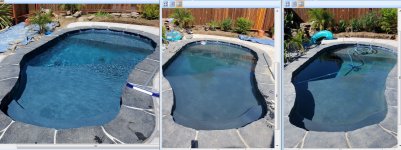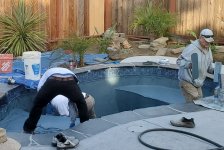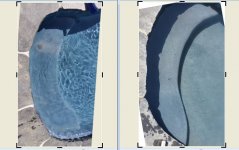So, long story short, I had my new pool plastered in May. After months of stressing over the color, I opted for a DiamondBrite Quartz Manzanita. The color turned out perfect. (see first picture). Jump ahead to August. Pool service guy screwed up and poured too much muriatic acid in water. Left a black stain on the front shelf right under the water jet. Got supervisor out and he was able to "fix" the problem, however, I gradually began to notice that lovely blue was turning into a blah grey. (see middle picture). Deep end of pool was now more of a greenish color and water was very cloudy. (Best way to judge color difference is compare the blue tile over the rear shelf - it matches blue on shelf in first picture but stands out in the middle picture). I needed to leave home shortly after supervisor arrived but could notice a little difference had occurred. Once I came home water was much clearer but the plaster is still overly grey. Unfortunately, these pictures make the pool look great, in real life the grey is much more prevalent. Supervisor probably knows what he's doing, says higher pH (along with some other factor) is key to trying to reduce the effect escaping calcium is having on the plaster. Plaster guy says acid was responsible for drawing out the blue pigment. Anyway, I'm done with trying to convince myself to be satisfied with this "new" color. I have tried some sanding and even using a pumice stone to see if sanding the plaster can reveal the original color. All it does is just get darker, but at least it's a dark blue. Replastering will cost me more than the original coat, around $5000. I think the pool service company needs to cover this so I let the supervisor know I wanted him to come by again and I'll see what his reaction is. Is there anything mechanical that might work to reveal the original plaster color? I'm leaning towards using some "diamond sanding blocks", like hand-held sanding sponges, or purchasing a pool plaster polishing/sanding pad and going at it with an angle grinder.


Last edited:






